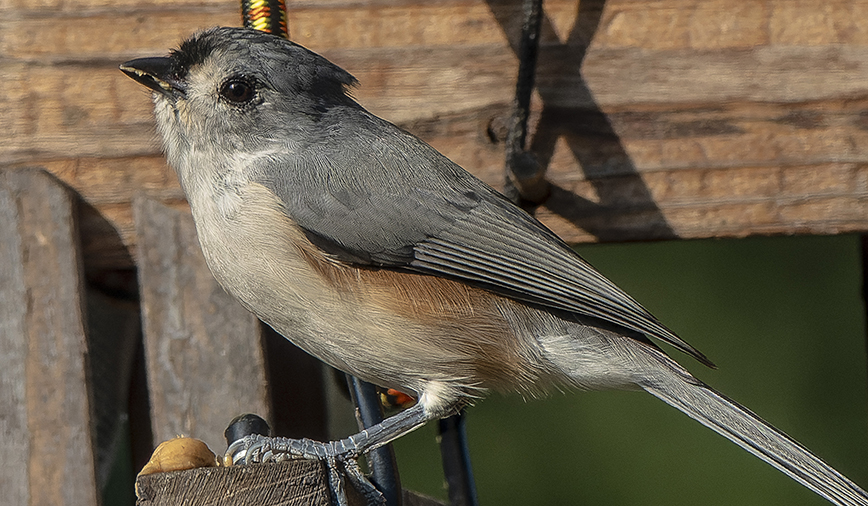Knock knock… Who’s there?
For those of you who live in houses with certain types of wooden siding or shingles, this time of year your visitor may be a bird. Those same shingles/shakes/clapboards that caught your eye as a home buyer can prove irresistible to your industrious neighbors the Downies, Hairies, Red-Bellieds, Flickers…or Chickadees!
Right now, these cavity-dwelling species are in the market for two things: food and shelter. If what you’ve been hearing sounds like the random taps of a hunt-and-peck typist, and the tapping takes place over a fairly broad area, it’s likely that your bird is, well, hunting and pecking. Its menu this time of year includes insects in diapause (a bug’s version of hibernation) as well as egg cases and pupae, with a few spider egg sacs thrown in for good measure. These morsels may be hiding out between the boards of your siding or underneath the cedar shingles. Either way, a hungry bird will sense and seek them out, leaving small nicks and dings as signs of its search.
If, on the other hand, the taps are more forceful in nature, and concentrated in one spot, your visitor has homebuilding on its mind. Woodpeckers, and chickadees too, frequently excavate winter roosts, or cavities, in trees–or wood-sided houses–to provide shelter from wind and snow.
Although dead trees would seem to be the natural choice for such activity, such finds are in short supply in suburbia. Plus, some birds have discovered that human homes, in some ways, are even better. Siding is soft and easy to dig into; the insulation behind the siding improves heat retention inside the cavity; and sides of houses are relatively predator free. Like the realtors say, location, location, location…
But bird-homeowner interactions don’t stop there. As the seasons progress, our local woodpecker species may opt to use your home for a third important purpose: drumming. Even though January and February are still very much in the “winter” section of our human calendars, these months have increasingly longer day lengths—a sure sign that spring, and mating season, are on their way. Drumming is the way male woodpeckers declare territory and they do so with gusto, banging their bills against a resonant surface in a rapid, staccato rhythm.
As it turns out, many house parts make great drumming surfaces. Metal gutters and downspouts are highly prized for their reverberation; cedar-shingled mansard roofs for their rich timbre; and siding, for its solid tone and ready availability.
When spring does roll around, the birds may come knocking yet again, this time in search of a nesting site. Nests differ from roosts in that two birds—the prospective parents—participate in the excavation, whereas a roost has just one excavator/occupant. And because nests are where young are reared, the birds are likely to become very protective of the area for a period of several weeks.
If you’re experiencing a conflict with a cavity-roosting bird…you’re in luck! The dedicated researchers at the Cornell Lab of Ornithology (located, coincidentally, on Sapsucker Woods Road in Ithaca, NY) have devoted considerable time and resources to the issue, and offer these recommendations:
• Repair or replace aging siding and/or shingles. Wood that has been exposed to the elements for long periods can start to weather and soften, which creates a surface attractive for excavating.
• Create visual disturbances by hanging windsocks, strips of mylar or foil, or, my favorite, shiny plastic pinwheels
that spin in the wind near areas that woodpeckers are interested in.
• Make noise. Bang pots and pans as the birds alight, or install motion detectors that emit a sound when
creatures come near.
• Cover existing holes with aluminum flashing or plug them with wood putty; just make sure no birds roosting
inside!
• Consider erecting a winter roost box—a structure larger than a traditional nest box, with perches inside for
birds seeking shelter.
• Avoid sticky repellents, which can adhere to a bird’s plumage and impair its ability to fly and keep warm.
Bird visitors got you down? Give these methods a try, and keep your fingers crossed. Or, even better, knock on wood.
Pam Otto is the manager of nature programs and interpretive services at the Hickory Knolls Discovery Center, a facility of the St. Charles Park District. She can be reached at 630-513-4346 or potto@stcparks.org.
October 23, 2015
Cavity Roosters
With dead trees in short supply in suburbia, many birds—such as this black-capped chickadee—opt to excavate roosts on wood-clad houses.

